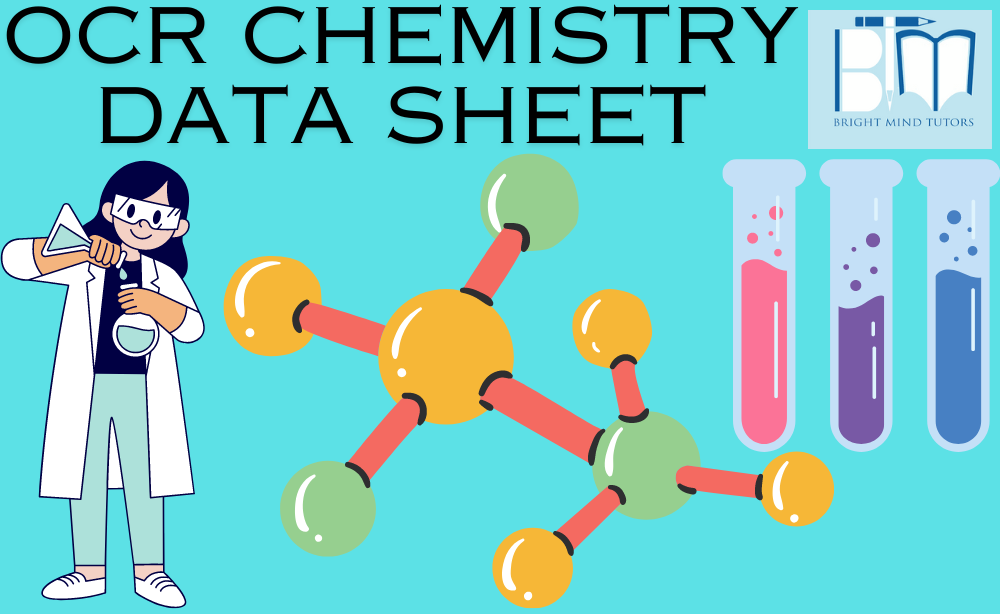Before we start discussing OCR A Level Chemistry Data Sheet, we will discuss general information, which is important for every student to know. Before discussing the data sheet of chemistry A Level, let’s start with an overview of OCR A Level Chemistry. Students can learn each concept of A Level Chemistry in detail from A Level Chemistry Tutor Online at Bright Mind Tutors.
What is OCR A Level Chemistry?
OCR, which stands for “Oxford, Cambridge and RSA Examinations,” is a British exam board. They create tests and qualifications for schools, colleges, and employers. OCR offers various qualifications like GCSEs, A-levels, job-related qualifications, and apprenticeships. Their qualifications are respected by universities, employers, and professional organizations in the UK and globally.
OCR A-level Chemistry is a UK qualification which is designed for students between the ages of 16 and 18. Typically, it is a two-year course, this comprehensive course covers various concepts such as organic, physical, and inorganic chemistry. The primary objectives of A-Level Chemistry include improving students’ understanding of essential chemical principles alongside improving their practical skills, analytical thinking, and problem-solving abilities. Universally acknowledged by both higher education institutions and employers, the OCR Chemistry A Level qualification stands as a favoured option among individuals aspiring towards professions in science, medicine, engineering, and allied disciplines.
OCR Chemistry Data Sheet
| General Information |
| Molar gas volume = 24.0 dm3 mol–1 at RTP |
| Avogadro constant, NA = 6.02 × 1023 mol–1 |
| Specific heat capacity of water, c = 4.18 J g–1 K –1 |
| Planck constant, h = 6.63 × 10–34 J Hz–1 |
| Speed of light in a vacuum, c = 3.00 x 108 m s–1 |
| Ionic product of water, Kw = 1.00 x 10–14 mol2 dm–6 at 298 K 1 tonne = 106 g |
| Arrhenius equation: k = Ae –Ea/RT or ln k = –Ea/RT + ln A |
| Gas constant, R = 8.314 J mol–1 K –1 |
| Triplet base codes (codons) for some amino acids used in mRNA |
| Glycine GGU |
| Alanine GCC |
| Leucine CUG |
| Serine UCG |
| Aspartic acid GAU |
| Glutamine CAA |
| Valine GUC |
Characteristic infrared absorptions in organic molecules
| Bond | Location | Wavenumber/cm–1 |
| C–H | Alkanes
Alkenes, arenes |
2850–2950
3000–3100 |
| C–C | Alkanes | 750–1100 |
| C=C | Alkenes | 1620–1680 |
| aromatic
C=C |
Arenes | Several peaks in range 1450–1650 (variable) |
| C=O | Aldehydes
Ketones Carboxylic acids Esters Amides Acyl chlorides and acid anhydrides |
1720–1740
1705–1725 1700–1725 1735–1750 1630–1700 1750–1820 |
| C–O | Alcohols, ethers, esters and carboxylic acids | 1000–1300 |
| C≡N | Nitriles | 2220–2260 |
| C–X | Fluoroalkanes
Chloroalkanes Bromoalkanes |
1000–1350
600–800 500–600 |
| O–H | Alcohols, phenols
Carboxylic acids |
3200–3600 (broad)
2500–3300 (broad) |
| N–H | Primary amines
Amides |
3300–3500
ca. 3500 |
Now you have an idea about the OCR Chemistry Data Sheet. You can revise all the general information mentioned in this blog post so you can have an idea about the data sheet of chemistry.
Do You Need Help from an A-Level Chemistry Tutor?
If you need to receive support and guidance from A Level Chemistry Tutor Online, then you can also get in touch with Bright Mind Tutors where we guide students and help them clear their exams with the desired score. The best thing about Bright Mind Tutors is that you can also book a free trial with us so you can decide whether you are satisfied with our tutoring services. Moreover, if you want more information regarding the chemistry data sheet, then reach us today.
Conclusion
Now that you have an idea about the data sheet of OCR Chemistry A Level along with its general information you must know. If you are looking to receive guidance or tutoring, then you can get in touch with Bright Mind Tutors.
CLICK ON THIS LINK TO DOWNLOAD => OCR Chemistry Data Sheet
Other Useful Links:

